THIS IS THE EK-STATIC CITY: THOUGHTS ON KIM HYESOON’S POETRYAND POETICS
***
In “Poetry of Hearing,” Kim Hyesoon has this to say regarding the spirit: “Does it stay “outside” and take over someone (a woman in particular) ….. Or is the spirit something that gushes out from someone’s insides— someone who is ill and in severe pain, ….. like a virus, like love, or something that is called a ghost because it is nameless?” (Princess Abandoned)
Hyesoon’s poetry and poetics have mainly been discussed in terms of the grotesque, but they also hover around questions regarding the experience and performance of spirit. I see the ek-static as the experience of spirit, and ek-stasis to be its performance. Ekstasis seems to be a necessary bridge between Kim Hyesoon’s atavistic discussion of spirit in her poetics and the violence it informs, experiences, and envisions in her poetry, in that the symbolic and its identification with the grotesque is also the ekstatic or, in Norman O. Brown’s sense, the telepathic, a merging of bodies, or, the spirit’s experience.
READ MORE >
September 18th, 2013 / 11:24 am
First Study for a Long Walk: Castle to Castle
Lynn Xu and I are married, and we’re also poets. For the past year we’ve lived in an interdisciplinary residency in Germany, in a community of artists and all sorts of people we don’t usually get to hang out with: architects, new music composers, choreographers, filmmakers, even a chess Grand Master and a video game sociologist. Soon we will return to the States and to the small vacant lot in West Texas that we call our home. In order to continue conversations we’re having, and to drag art further into our life together, we’ve come up with a project called Architecture for Travelers. At its center is a collaboration with our friend Alan Worn, with whom we’re designing a house and a cottage where we can host residencies for creative people. There will also be poetry, photography, and a long journey involved. We’re not crowd-funding, but we are taking pre-orders for limited-edition photographs and books to help out with expenses. ( For more detailed info, visit our website.)
Beginning in November, I’ll spend a month or so walking 700 miles from my birthplace on Galveston Island to our property on Galveston Street in Marfa, sometimes accompanied by family and friends. Today Lynn and I went on a practice walk, and for the first time incorporated another aspect of the planned trip across Texas: taking photographs each hour on the hour (5 today, about 240 in Texas). We set out from our studio at the Akademie Schloss Solitude and four hours later arrived at Schloss Ludwigsburg. This is the second time I’ve traveled between these two castles on foot, the first was this past winter with friend, collaborator, and artist Charlotte Moth. Robert Walser wrote “A walk is always filled with significant phenomena, which are valuable to see and feel,” and both trips from Schloss to Schloss have lived up to this proclamation. During the first some of our ideas were dreamed up, and this time some details became clearer. Here are the five photographs from today’s walk, along with written sketches about our time on the road.
***
1.
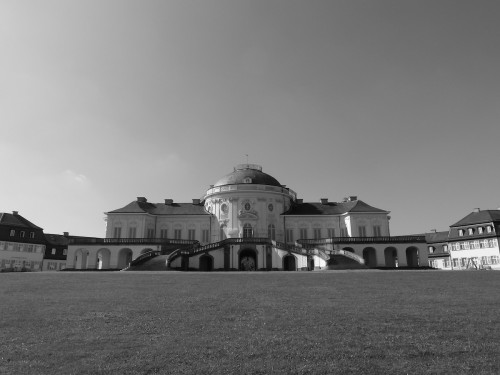
We left at eleven this morning. Heading down the big hill Schloss Solitude sits atop, we could see the straight-as-an-arrow path we’d be following stretched out for six or seven miles, after which it disappears over a wooded hill. I turned around and photographed our starting point. It made me think of Wallace Stevens’s “Anecdote of the Jar”: “It made the slovenly wilderness / Surround that hill.” Despite a forecast of showers, the weather was perfect and the skies were blue and clear all day long.
2.
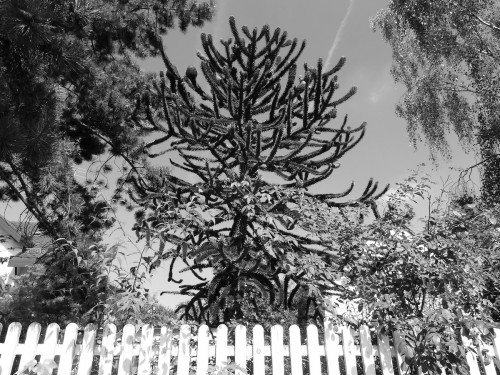
At the one-hour mark we were crossing through the outskirts of Stuttgart. There was some interesting architecture to be seen, but as the clock tolled the best thing around was a tree that Lynn spotted in a front yard behind a white picket fence. It was terrifying. It looked both totally out of place and too perfect for the suburban landscape. As we walked on, we talked about the best way to display the 240 photographs that we’ll have at the end of the Texas journey.
25 Points: Memories of Underdevelopment
 Memories of Underdevelopment
Memories of Underdevelopment
by Edmundo Desnoes, translated by Al Schaller
Latin American Literary Review Press, 2004
110 pages / $15.00 buy from LALRP
1. Memorias del subdesarrollo. Or call it Inconsolable Memories, which shows up in the subtitles of Tomás Gutiérrez Alea’s film adaptation, and is itself a wish taken from Hiroshima, Mon Amour, one of the narrator’s favorite movies. J’ai désiré avoir l’inconsolable mémoire.
2. I’ve looked up “underdevelopment” in the dictionary twenty times since seeing the film and reading the book. I’m waiting for the definition to say: a better word for this word is subdesarrollo.
3. The film was shown during Revolution in the Air: The Long Sixties.
4. The longer the 60s, the shorter the 50s and 70s.
5. We’re talking about how to get to Cuba the way our grandparents talked about how to get to the suburbs and their parents wondered how to get west. “I already know the United States, but what will happen here is a mystery to me.”
6. The author photo shows Edmundo Desnoes with full white beard, pipe in mouth, arms over his head in a pose of relaxation, not surrender. “The first responsibility of a writer is to survive.”
7. Reading books after seeing the movie. I made this mistake with The Firm. Even though I find Jeanne Tripplehorn attractive, and love typing out her name, Abby McDeere is shapelier on the page.
8. The novel’s first person antihero, Sergio Malabre, has less poise/élan than a Grisham creation (or Tao Lin) and believes himself, like so many first persons, to be the last man. He’s not a drinker but there’s probably something wrong with his liver. With his wife and family off to America he decides to stay in Cuba, an island he calls a trap, and to live amongst a revolution he calls a tragedy. On a crowded bus he feels like slime. “I am 39 years old and already an old man. I feel stupid. More rotten than mature.” The theme of rottenness in Memories of Underdevelopment is slightly less romantic than DeLillo’s “apple core going sepia” at the close of Underworld. Sergio, our rotten and rotting antihero, is play acting through the period drama of the future. His actual life is something Donald Draper will make a Park Avenue Sad Face about. He does not want what he wants. He does not want the historical anchors his country offers him. In protest, he removes the timestamps from his journal midway through the novel because he believes dates are meaningless. July 26, 1953. April 17, 1961. October 14, 1962. He’s a cultured, good-looking, overripe intellectual educated in New York and Paris (he’s done the 90 miles; no matter how far away it is, it’s always the 90 miles) who wants to know less, who wants to be stupider. #bayofpigs #Octobercrisis #CMC #gameofchicken.
9. As self-aware as Ben Lerner’s cipher in Leaving the Atocha Station, who, following the 2004 Madrid bombings, finds the air alive “less with the excitement of a period than with the excitement of periodization.”
10. Sergio, on a walk through the Hemingway house museum: “Americans have an artificial smell, and the Russians stink.” READ MORE >
September 12th, 2013 / 3:08 pm
25 Points: Creature
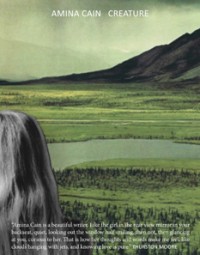 Creature
Creature
by Amina Cain
Dorothy, a publishing project, 2013
144 pages / $12.20 buy from Dorothy, a publishing project
1. I am ashamed of what I think about book reviews.
2. “I’m […] ashamed of what I think about literature—I can only open up to a few people in this way.” So says the narrator of “The Beak of a Bird,” the fourth short story in Amina Cain’s Creature (Dorothy, 2013). For now, I am hovering 40,000 feet above the Earth.
3. My thoughts about texts exist as emotional impressions, and what interests me most as a reader is ambience and affect—words as molecules of emotion, states of agitation, decorative illuminations, background noise. Readerly impressions in my bones are intimate like pages; they are, as in Creature, “the place where [my] life unfolds.” I want to recite my Creature to you, but instead draw inward toward the place where my body’s median axis, its midline, is askew.
4. Preoccupied with atmosphere and feeling as I am, I am ashamed of what I think (or don’t think) about literature, and so I choose not to write about books. But Amina Cain’s Creature is different: Amina Cain’s Creature resides out of harm’s way, although it exists in savage and erotic twilight. “I expressed myself through the violent putting away of a pan.” “Myself, alone, in my bed, is a story.” “Write about the arm when the whole body is being abused.” “We watch something violent on my laptop. It will help me wear this dress.” In this darkness, I read and write and think-along, and feel involved in every sentence. This involvement is key to my wanting to recite my Creature. Involved in it, I am pleased to feel ashamed of what I think.
5. Creature begs to be watched. Passing over one’s horizon of attention, the book is a meditative practice, which is not to say Creature is necessarily a meditation, for a person does not read Creature so much as she suspends it in space. 40,000 feet above the Earth, she observes its sentences, lines of thought that move across the mind, and breathes them in and out. There are momentary pauses of deep calm. It is likely the mind wanders. And as Creature unravels, the body sheds itself.
6. I am ashamed of my physiological responses to literature. See Exhibit A, which I am sorry to describe. In this disgraceful scene, I am hovering 40,000 feet above the Earth reading Creature’s “Attached to a Self.” I am attempting momentary pauses of deep calm. In the midst of this exercise, I cross a passage wherein Cain refers to a Benedictine monk: “The word is supposed to send a person into great silence,” she writes. “Just a little bit of reading is enough.” I suspend the statement in space, let it resonate. My eyes trace the sentence and tear.
7. Am I crying because of the story, someone asks, or because of the space?
8. Am I crying because of the space, I wonder, because this is the space where my life unfolds?
9. And is it really me if I’m not there?
10. To answer these questions for you, let me describe where Creature rests in my body—deep within my thoracic spine, in the middle of my vertebrae alongside photo booth-sized images of unrequited knives. I am conscious of it as I watch my body read. Its language moves and settles. This process of watching—as opposed to thinking—may seem enigmatic. It is. READ MORE >
September 5th, 2013 / 4:51 pm
A Child is Being Killed by Carolyn Zaikowski
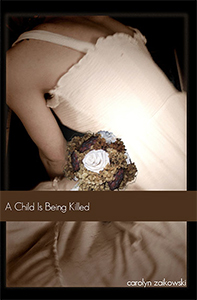 A Child is Being Killed
A Child is Being Killed
by Carolyn Zaikowski
Aqueous Books, 2013
162 pages / $14 Buy from Aqueous Books
A doubling is also a fracture. It’s a breaking apart. Carolyn Zaikowski’s novel A Child is Being Killed knows deeply this violence of the double, enacts it time and again. It’s the site of the book’s hopelessness, but also of its hope.
*
A Child is Being Killed tells the story of Shrap, a teen girl whose father sells her into sexual slavery in exchange for his rival’s business. It’s at least as dark as it sounds. Shrap is imprisoned, beaten, raped, and subjected to scientific experiments. She lives in a world where endlessly repetitive trauma distorts all sense of time and place, an opaque anywhere-dystopia in which sensation and fantasy are all that she can hold on to. A Child is Being Killed is also about escapes, however partial or temporary. It is a book written with grace and passion, and it probably deserves a much more thorough discussion than I’m giving here. Still, I will offer these thoughts as a part of the larger conversation that the novel should generate.
*
The first double/fracture comes in the book’s title. In A Child is Being Killed, the verb ‘to be’ is repeated in different forms. This has a few effects. The wording holds the horror of killing in suspension. A child is being killed. The killing is neither something to happen (therefor stoppable) nor something that has happened (that can be overcome, or at least dealt with). The killing is happening. The book is written under the sign of a horror in process.
And what of the semi-repetition of ‘to be’? The doubling pounds home the fact: This is happening. This cannot be escaped. The cruel truth of the title’s double ‘to be’ is that even if you get rid of one, a child’s still killed. Even if you lose them both you get A Child Killed. At the same time the extra ‘to be’ distances the word ‘child’ from ‘killed’. It gives a gap, and in that displacement there is life with its ever-present hope.
September 3rd, 2013 / 12:55 pm
No End to Things That Are Not Holograms
The company responsible for the Tupac hologram that performed at Coachella last year, Digital Domain Media Group, recently went bankrupt, somehow, despite the millions pouring in from investors, the $400,000 Dr. Dre himself reportedly paid for the puppet Tupac, and funded plans they had to resurrect Elvis as a hologram and possibly pitch holograms to political candidates to deliver virtual speeches this upcoming election.

Ok, so Tupac is double dead now, him and his hologram. Sort of. I mean some still insist he is not physically dead, but one thing for certain I feel moved to clarify is that he was never a hologram. Not even remotely close.
The Tupac hologram was simply a high-quality isolated video projection (niced up with 3-D graphics to provide depth cues) on a transparent screen (a sheet of mylar stretched across stage). Not very different, technologically speaking, than what you see when you go to the movies. It was sold as a hologram because it seemed like a free-moving 3-D object “beamed” from some magic device, like what we saw in the first Star Wars movie when Princess Leia sent an image of her bodily form to convey a message to Obi-wan instead of just simply sending a recording of her voice or some writing. (The significance of her using her whole, three-dimensional (but shrouded) body to plead her message, virtually, is a topic for a different article, but of course this fictional technology is already inspiring a robust pursuit at MIT.)
The real name for what you saw in the Tupac trick, or in Gorillaz “live” stage performances of its cartoon members, or in Hatsune Miku, a blue-haired Vocaloid anime girl/voice synthesizer whose songs can be created by users, is the Pepper’s Ghost Illusion, which you have seen if you’ve ever been through the Haunted Mansion at Disneyland. It’s a stage trick involving secret rooms, angled glass and lights that create ghostly images that seem to float and disappear midair. Although mentioned by some news sources, “Pepper’s Ghost Illusion” obviously doesn’t sound as technologically-advanced as “hologram”; in fact, it sounds a little quaint and old-fashioned, which is why marketers haven’t seemed to want to bring it up.
The only reason this misnomer bothers me is that it masks the true facts of real holograms, and the facts are wonderful, more wonderful than the facts of Pepper’s Ghost Illusion. I recently finished writing a whole book inspired by the facts of holograms borne out of an accidental obsession that started when, for no reason I can remember, I looked up holography on Wikipedia. READ MORE >
25 Points: The Rifle
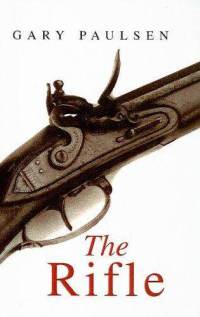 The Rifle
The Rifle
by Gary Paulsen
Laurel-Leaf Books, 1995
105 pages / $6.29 buy from Amazon
1. For my fifth grade class, Gary Paulsen was considered the pinnacle of literary merit. Second only to R. L. Stine.
2. Most people I talk to remember reading Paulsen’s novel Hatchet pretty well, but I’ve yet to meet anyone who remembers The Rifle.
3. The Rifle is about a man who carves a muzzle-loaded rifle out of a tree branch and spends a long time on it. He then sells it to a Revolutionary War soldier who dies of dysentery after killing a lot of British officers. Then an old man buys the rifle. He’s lonely and his life sucks, and the boy who lives across the street’s life is lonely, too. The boy’s dad is a trucker and doesn’t care about him. Then the man’s gun accidentally fires and kills the boy.
4. I lied about that.
5. I think in my memory I joined this novel with another novel that I read that same Summer as a kid. I dreamed an entire subplot about the little boy and his relationship with his trucker dad, writing him postcards and eating ice cream.
6. I think that book was written by Beverly Cleary.
7. She was pretty well liked in my grade school, too.
8. Here’s the real plot of The Rifle:
9. The book is even sadder than I remembered.
10. The muzzle-loaded rifle was made by a dedicated gunsmith and he did sell it to a sharpshooting soldier, but after the soldier dies of dysentery, the gun is stuck in an attic until a guy finds it and sells it to a dude at a gun show. The gun show dude is your stereotypical stand-yer-ground-pry-em-out-of-my-cold-dead-hands- lives-in-a-van-off-the-grid-type dude. This gun guy drinks a lot of beer and the omniscient narrator tells us that later he gets stomach cancer and dies. This stomach cancer guy’s van breaks down and he trades the rifle and an Elvis painting on velvet to a mechanic for van parts. The mechanic takes both the gun and the painting home and places them on his mantel. Then one day, he’s lighting a fire in the fireplace and a spark from the fire lights some old powder in the gun and it goes off and the bullet flies through the house and kills a little boy who lives across the street. Then the novel discusses how the loss of the little boy’s life ruins everyone else’s lives. READ MORE >
August 29th, 2013 / 2:28 pm
Snapchat, the Opera
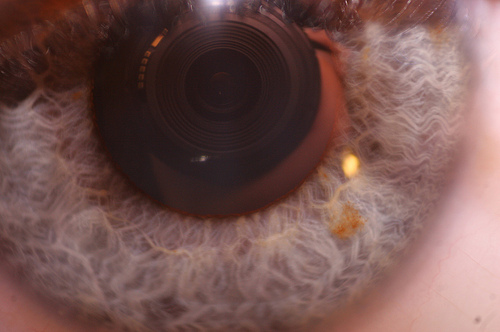
I take out my iPhone to start filming us in bed. Turned on my side, with my elbow bent to prop my head up with one of my hands, the other hand holding my phone. Through the screen I can see a close up shot of Adam’s nose and mouth. I pull back to see his entire face. I look beyond my phone to see his full body laying out in front of me. Adam starts to perform:
“Hi Lucy”
“What? [laughter] She’s not going to see this.”
“Isn’t this a Snapchat?”
“It’s not a Snapchat”
“You’ve been making Snapchats all morning and then you go and switch it up on me!”
“You can’t be so presumptuous”
“I’m hiding under here… For forever or until your battery runs out.”
“I brought my charger today”
“Ok, until your phone runs out of space.”
“My phone has unlimited space for embarrassing videos of you.”
“Oh my god… you’re adding this thing to our life. It’s like this wild animal. A barracuda.”
“I don’t understand. The camera’s a barracuda?”
“Yeah”
“There’s an interesting passage about cameras in this [Immortality by Milan Kundera]. There’s like this whole chapter about being watched and how when you’re filmed your self is taken away from you and put in the control of someone else.”
“You’re stealing my soul.”
“I mean, your self exists in the camera now. It’s fragmented.”
“I don’t know… I think people change when the camera comes on. You’re not the same.”
“I think so too but I think that’s part of yourself. I don’t think that change draws from something outside of yourself.”
“Yeah, but it [the camera] obfuscates it.”
“I feel like whenever I feel obligated to turn on a personality its always based on something I wish I was naturally, or how I think I need to be in the situation, and I don’t think that… I think that the fact that I’m able to draw on that personality and bring it out on command says that its always been a part of me. I’m relying on scripts and commands that I can recall for specific instances.”
“But that’s only if you’re a good actor. I feel like I just shut down. I’m not as good.”
“Yeah?”
‘The part of me that’s not as self-conscious is gone.”
“Oh here it is…
[From Immortality by Milan Kundera]
‘It was a meaningless episode: some sort of congress was taking place in the hotel and a photographer had been hired so that the scholars who had assembled from all parts of the world would be able to buy souvenir pictures of themselves. But Agnés could not beat the idea that somewhere there remained a document testifying to her acquaintance with the man she had met there; she returned to the hotel the next day, bought up all her photos (showing her at the man’s side, with one arm extended across her face), and tried to secure the negatives, too; but those had been filed away by the picture agency and were already unobtainable. Even though she wasn’t in any real danger, she could not rid herself of anxiety because one second of her life, instead of dissolving into nothingness like all the other seconds of life, would remain torn out of the course of time and some stupid coincidence could make it come back to haunt her like the badly buried dead.’
Is that how you feel about this video [laughter]?”
“I mean, I feel like its definitely ruining my life. Slowly.”
“That’s funny. I feel only positive about being recorded and documented.”
“You were like a theatre major! This is like your shit! You’ve got your reading voice on, you’re good to go.”
“Am I doing my reading voice right now?”
“No, but you were.”
“But that’s different. I was reading.”
“Remember when you turned on the camera the other day and immediately went into your recording voice?… Are you still recording?”
“Yeah.”
“Oh no…”
“I think its different though.”
“How do you mean?”
“I mean, I’m the one recording you. Not some omniscient, malevolent entity. Its an intimate moment and we have control in it.”
“But its not an intimate moment.”
“Just because the camera is there?”
August 28th, 2013 / 1:18 pm
25 Points: City Water Light & Power
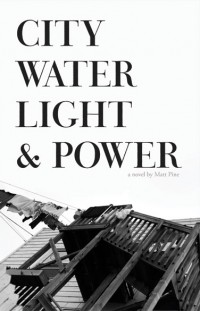 City Water Light & Power
City Water Light & Power
by Matt Pine
Cairn Press, 2013
180 pages / $18.00 buy from Amazon
1. I’m in awe of Matt Pine’s prose style. A lake has “the same texture and tone as ink spilled onto silver.” A black dress has “the same cling and quality as plastic wrap on American cheese.” These similes give me goosebumps.
2. The frisson of encountering high style in a world that no longer much values it.
3. City Water Light & Power explores the angst of being young in the city and not knowing the score. It’s about twentysomething Chicagoans figuring out how to survive in body and soul — the alternatives, in this novel, are selling out or breaking down, in bars where salaries are “revealed like flashed genitalia” or in alleys where it’s “spiritually dangerous walking there dispirited after dark.” Your choice is to be one of the manipulators, or someone who walks without a destination — both flavors of desperation.
4. Chicago is a character in this novel. A machine whose workings are dangerously hypnotic.
5. A study of corruption and alienation that gives me that sense of a ruthless and inscrutable society I get from Fitzgerald, say, or Salinger. Matt Pine writes of venality in a tone of innocent fascination — he is sensual, aggrieved, and mystified by ordinary life, in a classic American tradition harking back to the Puritans.
6. The demolition of a dive bar stands for what’s being lost. The bar is called Lewis & Carol’s… perhaps to suggest a world down the rabbit hole or through the looking glass?
7. I like it that this bar seems to be the only thing keeping Jake from becoming an alcoholic – after its destruction, Jake takes to drinking outdoors. Somewhat illogically since the novel acknowledges there are other bars in Chicago – one might even say too much of this novel takes place in bars… But these bars are full of phonies, not like Lewis & Carol’s, which stands for community.
8. Many first novels by men include a dazed and confused main character. In this case, Jake. His job involves talking to imaginary customers. His free time is spent with an imaginary friend, a woman visible just to him, who communicates only through mime and gymnastics and might work better in a movie, a mute hallucinated character being tricky to pull off in a novel…
9. Adrian is a character who success brutalizes. He is seeking the wrong nourishment, acquiring what David Mamet has called “the canting language of the real-estate crowd.” There’s beauty in the process of making ugliness happen, Pine suggests, but it’s a lonely beauty.
10. Jake is a half-hearted preserver, Adrian a developer. Jake on Chicago – “But I wonder what it is we’re wanting after. If it’s really the city, I mean. Do we want more of it, or do we want what it was? I’m sorry. I’m not articulate today. I guess I wonder why we have to fight the city for it to stay itself? Because isn’t that stopping it from being itself? And yet it’s so glorious.” Adrian on Chicago – “What would lure a boutique? How many patios were necessary to make an enclave of patios? Did condos come before cuisine? But then who would move into this wasteland? But why would you open a business where no one lived? It all seemed to leap out all at once, all the parts dependent on all the parts, like a stone archway. But also like an archway, there must be a way to build one.” READ MORE >
August 27th, 2013 / 6:45 pm
25 Points: The Unknown University
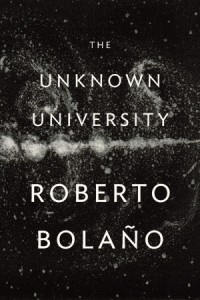 The Unknown University
The Unknown University
by Roberto Bolaño
New Directions, 2013
766 pages / $39.95 buy from Amazon
1. I’ve a strange attachment to Roberto Bolaño. One of coincidence and timing and love.
2. The Savage Detectives came out in the US six years ago, the same week I decided that—yeah, dammit—I was going to do an MFA.
3. I finished my MFA not too long ago (May-ish), just as the Bolaño Library seems to have exhausted its basement of posthumous manuscripts with The Unknown University, “a deluxe, bilingual edition of all the poems of the great Roberto Bolaño.” (Or so says the flap).
4. The Unknown University, really, reads more as a manuscript of notebooks. Poems incorporate drawings, caesuras become page-breaks, forms change again and again and again. At first, it reminded me of Jack Kerouac’s Mexico City Blues, in which every page of the book was in fact a typed page of a notebook’s musings. This feels like that, but rewritten from notebooks to computer and revised.
5. It’s 700+ pages and irresistible to a Bolañophile like me. A short story that recently ran in the New Yorker appears (“Mexican Manifesto”), as does the whole of the novel Antwerp, albeit in somewhat different form (and under the title “People Walking Away”). I didn’t do a full index-to-index comparison, but it also seems the whole of 2008’s The Romantic Dogs appears in a scattering throughout Part Three.
6. Despite these inclusions, though, The Unknown University isn’t a collection of previously-published books, like other “complete” collections can tend to be. (Just above my Bolaño shelf at home are the Collected Lydia Davis and Amy Hempel, which are exactly that).
7. Some such collections, like Jack Gilbert’s or Richard Hugo’s, have a section of “uncollected” pieces that follow the chronological reprintings. The Unknown University is sort of like one big “uncollected” section, but one that the author took the time to fashion into something that can live alone.
8. According to the note from the heirs: “The present edition corresponds exactly to the manuscript we found (with only a few minimal corrections taken off of his computer). Roberto himself dates it to 1993.”
9. These are early writings. An author’s note lists the completion of some sections as early as the 1970’s, when Bolaño was just Roberto, one of the boy-poet idealists he takes so often as subject in his fiction. In several poems he makes reference to his age (typically 26 or 27), which would have been around 1979-80.
10. One could imagine The Unknown University as the texts Bolaño wrote during the time of his writerly maturation, for what many now is the MFA. READ MORE >
August 22nd, 2013 / 11:00 am

